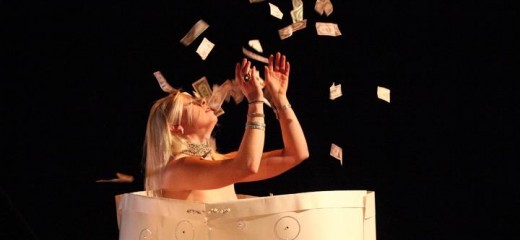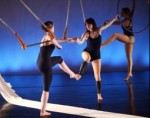
Balloons and Flowers for Spiel Uhr
By Peter Price
With so many showcase series a part of the current dance landscape it is easy to forget that there was a time when this was not the case.Group Motion Company’s Spiel Uhr series has been running continuously since the 1980’s. Although its focus has shifted over the years, it has consistently remained a critical platform for Group Motion Company members’ own choreographic work as well as the work of emerging choreographers from the broader dance community. The success of this mix is largely due to Manfred Fischbeck’s open and encouraging curatorial vision. From time to time there might be some missteps – some work not quite ready for an audience – but in general one can be assured that there will always be something of interest to experience at Spiel Uhr. This past weekend’s iteration at the Community Education Center (CEC) was no exception.
The first work on the program, Big Lady, began with a sensuous and richly textured video by John Luna. Luna, better known as a compelling dancer for Group Motion, Brian Sanders and others, has been making increasingly sophisticated dance videos. This example was projected high with an extra wide aspect ratio – a sumptuous essay in overexposed whites and lavenders. In a memorable moment the film’s subject, Lindsay Browning, blows up a white balloon (a recurring motif of the evening as we see later) which fills the frame on which is projected Browning blowing up a white balloon which fills the frame on which is projected… etc – a mise en abyme increasing in speed with a slow zoom in.
When the film ends, the ethereal Browning of balloons, whites and lavenders is replaced on stage by an agitated Browning of black and platinum, repeatedly cutting the buds of roses off their stems with dance interludes of icy, heavy metal uprocks, and angular twitches. Browning has grown into a dancer of commanding presence over the last several years, and the choreography here (credited to both Browning and Luna) brought this into sharp relief. Big Lady indeed.
Group Motion Company veteran David Konyk’s duet with Hedy Wyland, What Remains, whimsically, yet wistfully explored characters and themes first presented this past September at thefidget space. Konyk took advantage of the CEC’s central aisle to present a dance lit from behind, and seen by the audience only in shadow on the back wall of the stage. In these flattened two dimensions and stark black-and-white, Konyk and Wyland became one dancer with a tendency to self-replication and temporal displacement. The music’s song lyrics reinforced the theme of loneliness and alienation of the self, even when the self is multiple.
The first half ended with an elaborate duet of dysfunctional couplings by Leanne Grieger and Adrian Plascencia. Derailed employed 50 or so white balloons as tokens of interpersonal emotional transfer, tending toward the cold and prickly. The work’s sophisticated partnering and precise dancing lifted it above the normative agonism of its characterizations. (See Note 1)
During intermission Lindsay Browning reappeared to sit nude in what looked like a paper bathtub and languidly stroked pieces of custom jewelry and fake paper money. This became the start of Darcy Lyon’s Tip These Turbulent Scales, described in the program notes as “a dance portrait that explores the relationship between financial stability and mental illness.” (See Note 2) By the end of the work it was not entirely clear what this relationship was. Heads were held despairingly in hands, money was dropped, thrown, and gathered frantically and mouths were covered in horror, while throughout Lyons made good use of Browning’s compelling stage presence.
Charles Tyson’s Haves, an excerpt from the new work Wishes, Wants & Haves upcoming next month at the Performance Garage, explored the idea “that we as humans tend to idolize our wishes, fetishize our wants and ignore our haves.” A voice-over explained to us that although we all want to be among the ‘élite,’ even if we feel we have nothing, if we really look at it closely we all have, well… something. Tyson, who plays a valuable community role as organizer and curator of the CEC’s “Etc. performance series,” showed that he had something to share choreographically with his able core of dancers. The five young women, all about the same height and body type, and dancing much of the time in unison with a performative visage of eroticized worry, looked repeatedly to their upturned palms as if to say, “Hey, what do I have?” between their hitch-kicks and stag-leaps.
The evening ended with a promising duet in progress by Eleanor Goudie-Averill and Pamela Vail with accomplished original music by collaborating composer Brandan Evans. The complete Mechanism is slated to premiere at the 2012 Philly Fringe Festival. Its theme of “finding humanity within machinery” through the appreciation of the moving body as mechanistic was visible in the jewel-like precision of its dancing for instance the wheels-within-wheels rotations of mirrored floorwork.
All-in-all the evening reminded me of what a valuable resource Spiel Uhr has remained over the decades and the importance of mixed bills in which choreographers with different aesthetics and at different career points share work at different stages of development to put on a show of depth and variety. Less experienced choreographers get a showing in the context of more polished work, and audiences coming for one choreographer or another mix and mingle and learn something about the broader community of dance makers.
***
1: The normative is not just the “normal,” but also the “norm,” or what is presented by a social force as what "should be" or as a limit. Agonism is the idea that the primary human interaction is the struggle for social advantage. ‘Normative agonism’ is the idea that this struggle for social advantage is, or should be, the norm – as opposed to cooperative or neutral human interactions. Normative agonism is an ideological precondition of contemporary American life as even a few minutes of T.V. watching makes clear. Artists, perhaps because they are concerned with so many things that "ordinary" people are not, often have out of the ordinary thoughts on the human condition, but just being an artist does not guarantee that this will be the case. The fact that choreographers fall into expressing agonistic human relationships – almost by default – when they engage in characterization is completely predictable. This is the work of ideology.
2: Much dance concerns itself with formal arrangements of the human body changing over time, regardless of whatever else it may be about. ‘Ideas’ external to these concerns, for instance about relationships between human beings not just as bodies in space but in social situations: from the most intimate and personal (familial, sexual), to the most abstract and public (political, economic), can be mapped onto the time-space shapes of the dance situation at any moment through additional communicative mechanisms external to what is happening on stage.
Many artists are concept driven and this in itself is in no way a problem. However attempts to be communicative about concepts by relying on the already known (program notes, sets and costumes, gestural clichés that have developed quasi-linguistic functioning, or processes of analogy and metaphor that function linguistically) can limit the ways in which a work can reveal itself as meaningful to a viewer. Does this mean that dance can have nothing to say about ‘ideas?’ Of course it can. But it also suggests that one job of the choreographer is to try to understand what does the ‘communicating’ and what does not.
Group Motion: Spiel Uhr, featuring work by Lindsay Browning, Darcy Lyons, David Konyk, Charles Tyson, Leanne Grieger, and Ellie Goudie-Averill. February 18 & 19, 2012, 8pm. CEC Meetinghouse Theater, Philadelphia. No further performances.
Editor's Note: Correspondent Peter Price has worked with Group Motion Company.
By Peter Price
March 7, 2012





.png)


